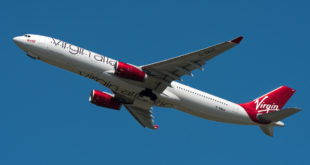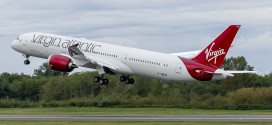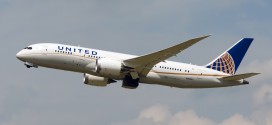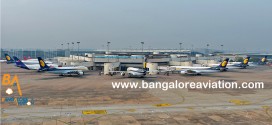New Delhi Indira Gandhi airport is looking to maximize efficiency of their runways via a series of measures.
Bangalore Aviation has learned that the airport operator Delhi International Airport Limited (DIAL) is working towards achieving a runway service rate of 104 movements per hour. This rate will include optimised pilot performance, optimised ATC performance and high intensity runway operations. Yet, despite these initiatives, challenges remain, which we examine.
An overview of the current runway environment
The airport operates three runways each of which pose a separate set of challenges.
Runways 10-28 and 09-27 are an “Open-V” configuration and cannot be operated as independent runways because of the converging departure paths or crossing approach paths.
Runway 11-29 has a highly displaced threshold thanks to rampant encroachment on one side, and a statue one the other, which has reduced the usable runway length by over 36% (from 4,400 metres to 2,800 metres). The civic authorities seem unwilling to take any action to address this. Added to this, that the runway is too far away from Terminal 1 which houses the low cost carriers like IndiGo, Spicejet and Go Air, who together contribute the lions share of traffic at the airport.
The excessive distance results in taxi times of 12 to 18 minutes adding to the fuel burn of 36 – 48 kgs. These challenges are highlighted below:
Current capacity and traffic flows
Delhi airport currently operates with 3 runways and a peak capacity of 67 movements per hour. This includes 62 scheduled movements and 5 non-scheduled movements (to cater to non-scheduled traffic and peak recovery). In optimal scenarios though, the airport has recorded up to 84 movements per hour.
Traffic flows into Delhi are organized by using an East flow or a West flow as below:
| West flow pattern | East flow pattern |
| Arrivals + Departures on Runway 29 | Arrivals + Departures on Runway 11 |
| Arrivals on Runway 27 | Arrivals on Runway 09 |
| Departures on Runway 28 | Departures on Runway 10 |
Other unique aspects
Delhi airport also has some other unique factors that limit the airspace usage. Specifically, the VIP areas to the North of the Airfield (including the Presidents Estate, Prime ministers house and other sensitive locations); Hindon Airforce base (which has several military routes) and residential areas.
Separation between aircraft on approach is maintained at 9NM per hour and each ATC controllers issues directions (vectors) to 10 aircraft on final approach (compared with a global benchmark of 5 aircraft per controller in London and Dubai). The final approach clearance is obtained 2NM or ~50 seconds prior to landing and the runway occupancy times at Delhi are approx. 40 – 45 seconds.
The challenge going forward
The challenge for Delhi airport is that air traffic is growing at 20% per year but the airport lacks runway capacity to accommodate this growth. A series of measures are being thought of and the UK firm NATS has been conducting a study jointly with the Airports Authority of India to initiate measures to increase runway capacity. Delhi airport maintains that upgrades to the terminals can help however this is a sore point with airlines in Terminal 1 who insist that more efficient use of the existing infrastructure is what is lacking. Industry sources indicate that this is a hot topic and a joint meeting of the Airport, Airlines, Airforce, ATC and regulators is likely to be called soon.
Stay tuned for updates.
 Bangalore Aviation News, Reviews, Analysis and opinions of Indian Aviation
Bangalore Aviation News, Reviews, Analysis and opinions of Indian Aviation



